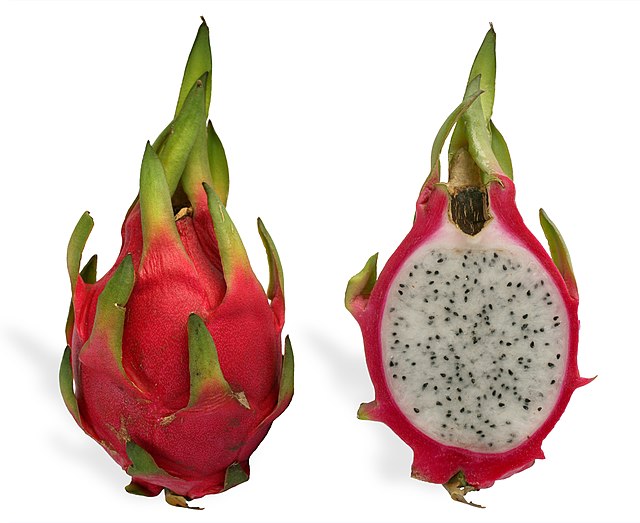Top Qs
Timeline
Chat
Perspective
Selenicereus
Genus of cacti From Wikipedia, the free encyclopedia
Remove ads
Selenicereus, from Ancient Greek σελήνη (selḗnē), meaning "moon", and Latin cēreus, meaning "candle", sometimes known as moonlight cactus, is a genus of epiphytic, lithophytic, and terrestrial cacti, found in Mexico, Central America, the Caribbean and northern South America. The term night-blooming cereus is also sometimes used, but this is also used for many night-blooming cacti, including Epiphyllum and Peniocereus. In 2017, the genus Hylocereus was brought into synonymy with Selenicereus. A number of species of Selenicereus produce fruit that is eaten. The fruit, known as pitaya or pitahaya in Spanish or as dragon fruit, may be collected from the wild or the plants may be cultivated.
Remove ads
Description
Clambering plants with flat to angled stems, producing aerial roots. Areoles may be with or without spines. Flowers are large and nocturnal, pollinated by moths or rarely bats. The receptacle bears small bracts, hairs and usually spines. Fruits bear numerous spines. Flowers are generally produced in abundance with mature plants and are typically white and are very fragrant and only last a single night in most species.[citation needed]
Remove ads
Taxonomy
Summarize
Perspective
The taxon was first described as a section, Cereus sect. Selinicereus, by Alwin Berger in 1905. It was raised to a genus by Britton and Rose in 1909. The name is derived from Σελήνη (Selene), the Greek moon goddess, referring to the nocturnal flowers, and cereus, meaning "candle" in Latin, a name used for upright cacti.[3] A molecular phylogenetic study of the tribe Hylocereeae in 2017 showed that the genus Hylocereus was nested within Selenicereus, so all the species of Hylocereus were transferred to Selenicereus.[4] As of March 2021[update], the transfer was accepted by Plants of the World Online.[2] The authors of the 2017 study also placed some species of Weberocereus within Selenicereus,[4] which was not accepted by Plants of the World Online as of March 2021[update].[2]
Phylogeny
The cladogram below shows the relationships found in the 2017 study of the tribe Hylocereeae.[4]
| Hylocereeae |
| |||||||||||||||||||||
Selenicereus belongs to the hylocereoid clade, along with Weberocereus. Members of the clade are mostly climbing or epiphytic, and have spiny ribbed stems, contrasting with members of the phyllocactoid clade, which are mainly epiphytic, and have spineless flattened leaf-like stems.[4]
Species
Species placed in the genus by Korotkova et al. in 2017 are listed below.[4] The list includes three species formerly placed in Weberocereus, whose transfer was not accepted by Plants of the World Online as of May 2025[update].[2]
Species formerly recognized include:
- Selenicereus boeckmannii – synonym of Selenicereus pteranthus[21]
- Selenicereus brevispinus – synonym of Selenicereus pteranthus[21]
- Selenicereus chontalensis – synonym of Deamia chontalensis[4]
- Selenicereus coniflorus – synonym of Selenicereus grandiflorus[11]
- Selenicereus hallensis – synonym of Selenicereus grandiflorus[11]
- Selenicereus urbanianus – synonym of Selenicereus grandiflorus[11]
- Selenicereus rubineus – synonym of Selenicereus inermis[14]
- Selenicereus wercklei – synonym of Selenicereus inermis[14]
- Selenicereus wittii – synonym of Strophocactus wittii[4]
Remove ads
Uses

The fruits of a number of species of Selenicereus (particularly those formerly placed in Hylocereus) are eaten. Selenicereus undatus and Selenicereus triangularis are widely cultivated in the Americas, Europe and Asia for their fruits, known as pitayas or pitahayas in Spanish, and as dragon fruits in Asia. The fruit of Selenicereus setaceus is eaten in South America.[32]
References
External links
Wikiwand - on
Seamless Wikipedia browsing. On steroids.
Remove ads


















